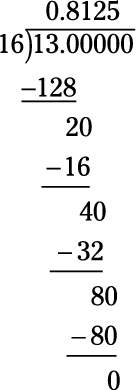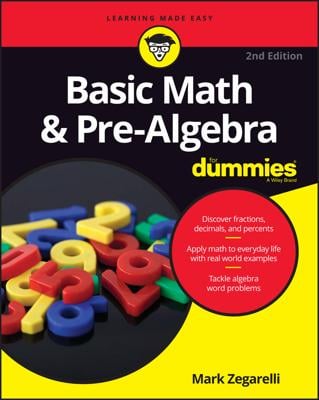To change any fraction to a decimal, just divide the numerator by the denominator. Often, you need to find the exact decimal value of a fraction. You can represent every fraction exactly as either a terminating decimal or a repeating decimal:
Terminating decimal: A terminating decimal is simply a decimal that has a finite (limited) number of digits. For example, the decimal 0.125 is a terminating decimal with 3 digits. Similarly, the decimal 0.9837596944883383 is a terminating decimal with 16 digits.
Repeating decimal: A repeating decimal is a decimal that repeats the same digits forever. For example, the decimal

is a repeating decimal. The bar over the 7 means that the number 7 is repeated forever: 0.777777777 . . . . Similarly, the decimal

is also a repeating decimal. The bar over the 91 means that these two numbers are repeated forever: 0.3459191919191919. . . .
Whenever the answer to a division problem is a repeating decimal, you’ll notice a pattern developing as you divide: When you subtract, you find the same numbers showing up over and over again. When this happens, check the quotient to see whether you can spot the repeating pattern and place a bar over these numbers.
When you’re asked to find the exact decimal value of a fraction, feel free to attach trailing zeros to the dividend (the number you’re dividing) as you go along. Keep dividing until the division either works out evenly (so the quotient is a terminating decimal) or a repeating pattern develops (so it’s a repeating decimal).
Practice questions
Convert the fraction to an exact decimal value.
0.5625. Divide 9 / 16:

Because 16 is too big to go into 9, attach a decimal point and some trailing zeros to the 9. Now you can divide:

What is the exact decimal value of the fraction 5/6 ?

Divide 5 / 6:
Because 6 is too big to go into 5, attach a decimal point and some trailing zeros to the 5. Now divide:

As you can see, a pattern has developed. No matter how many trailing zeros you attach, the quotient will never come out evenly. Instead, the quotient is the repeating decimal

The bar over the 3 indicates that the number 3 repeats forever: 0.83333333 . . . .
Practice questions
Change 13/16 to an exact decimal value.
Express 7/9 exactly as a decimal.
Following are the answers to the practice questions:
-

Divide 13 / 16, attaching plenty of trailing zeros to the 13:

This division eventually ends, so the quotient is a terminating decimal.
-

Divide 7 / 9, attaching plenty of trailing zeros to the 7:

A pattern has developed in the subtraction: 70 – 63 = 7, so when you bring down the next 0, you’ll get 70 again. Therefore, the quotient is a repeating decimal.

